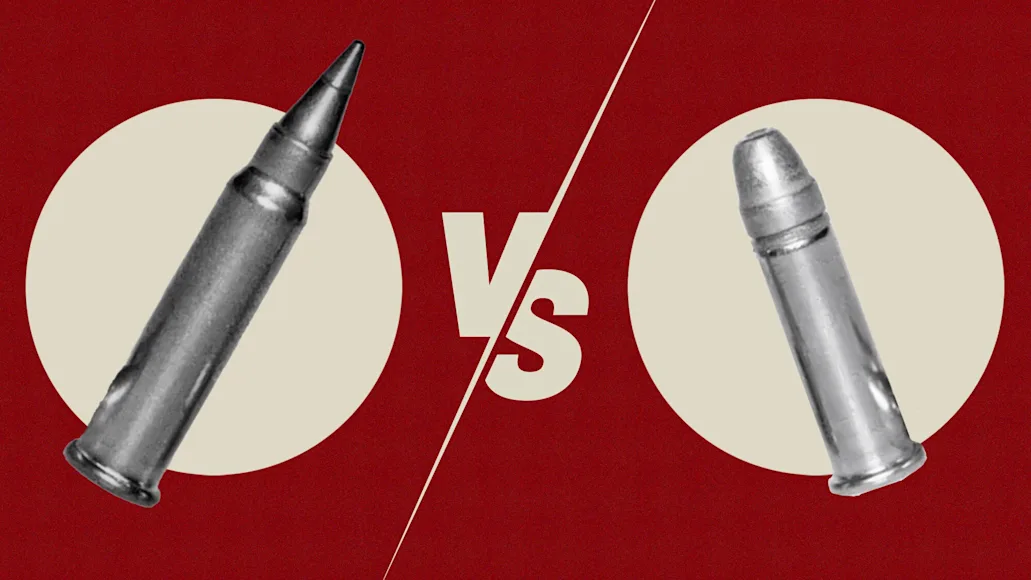We may earn revenue from the products available on this page and participate in affiliate programs. Learn more ›
In a perfect world, there would be a rheostat on the side of our rifles that let us dial in the ballistic performance we needed. Like a Star Trek phaser, if we needed to pop a bunny at 30 steps, we’d go with setting #1. If we needed to reach out to 150 yards to whack a rock chuck, setting #3 might be just right. Of course, that’s not possible, so we’re stuck picking a cartridge and sticking with it. It’s why we must contemplate comparisons like the 308 vs 30-06 and the 17 HMR vs 22 LR.
There is an endless collection of centerfire rifle cartridges to choose from but with rimfires, there are only five. The 22 LR is the most prolific and affordable. The 17 Winchester Super Magnum is the most powerful but the most expensive to shoot. Filling the middle ground, we have the 22 Magnum and the 17 HMR. There’s also the 17 Mach 2, but it is not and never has been very popular. It seems that most struggling to select a rimfire cartridge debate the 17 HMR vs 22 LR. Here are the similarities and differences between the two that will help you select the best round for you.
The 22 Long Rifle
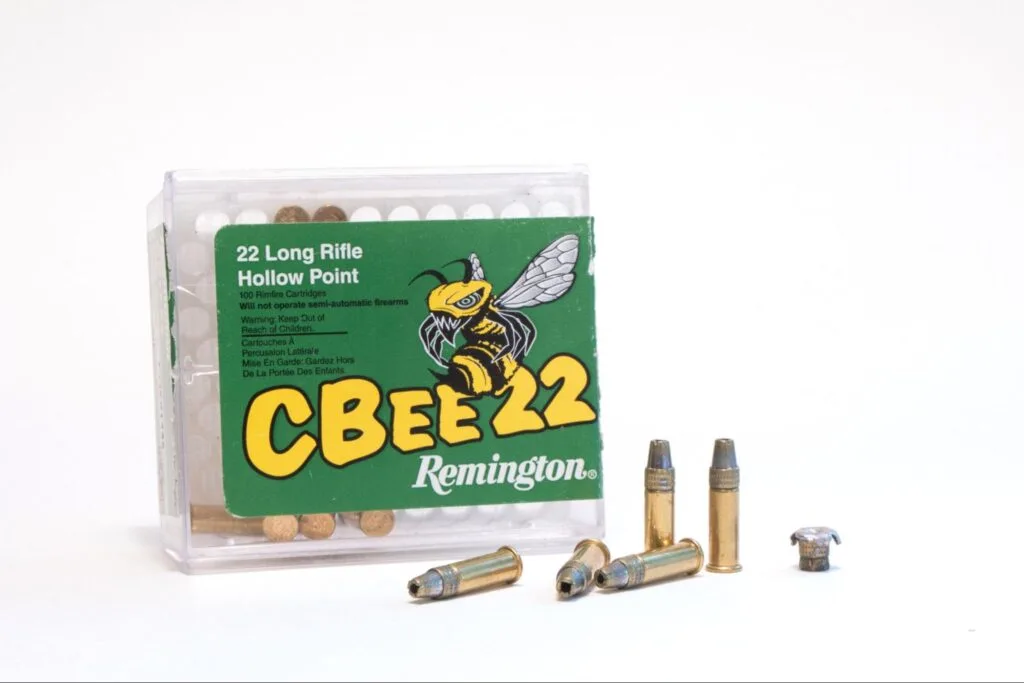
The 22 LR is the most versatile when it comes to the different loads offered. Richard Mann
This cartridge has been with us for more than 130 years. Over that time, it has been chambered in every type of firearm you can imagine, from derringers to tack-driving precision rifles. It is the cartridge most of us learned to shoot with and many of us first hunted with.
There are many different types of 22 LR ammunition, with bullet weights ranging from 20 to 60 grains. With standard loads, it will launch a 40-grain bullet to about 1200 fps. But there’s also high-performance 22 LR ammo like the CCI Stinger. The Stinger has a slightly longer cartridge case, but the overall cartridge length is the same. It will push a 32-grain bullet faster than 1600 fps. And then there are subsonic 22 LR loads that are as quiet as a whisper and even quieter when used with a suppressor.
The versatility of the 22 LR, combined with how affordable it is to shoot, is why it’s so popular. It has an effective range of about 100 yards, and inside that distance, it is ideal for plinking and good for hunting small game. Depending on the ammunition you choose, every time you send a .22-caliber bullet downrange, it will cost you between 10 and 50 cents. Additionally, there’s a wider selection of firearms available in 22 LR than for any other rimfire or even centerfire cartridge.
The 17 HMR
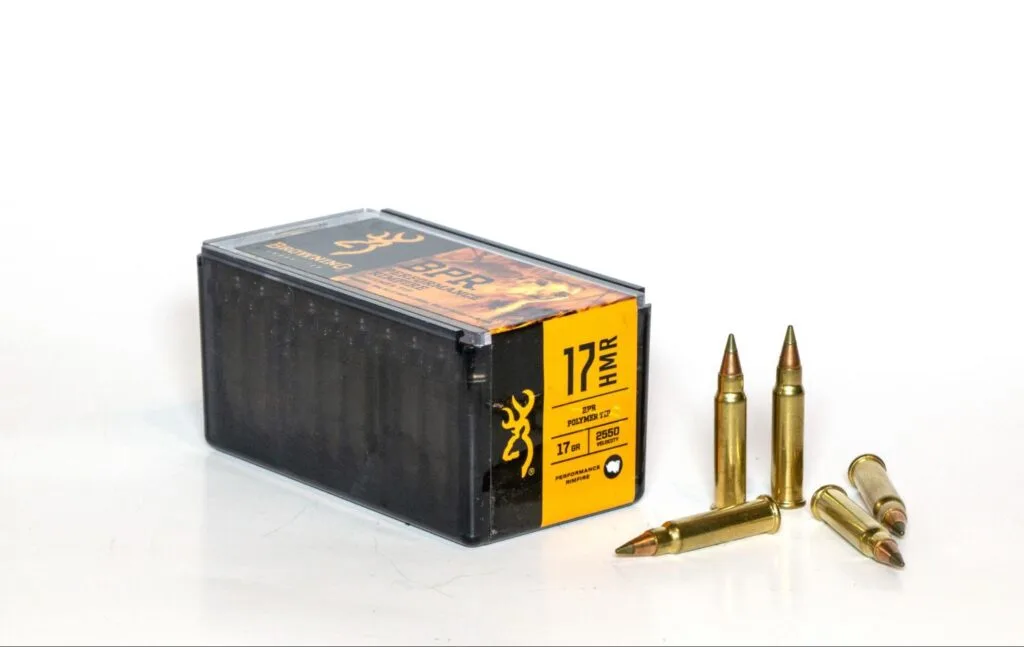
If small game hunting at extended distances is your thing, then the 17 HMR is one of your best options. Richard Mann
In 2002 Hornady shocked the world with the introduction of the 17 HMR (Hornady Rimfire Magnum). This rimfire cartridge, which fires a 17-caliber bullet, took the rimfire world by a storm. Bullets weighing 17 grains will leave the barrel of a 17 HMR rifle with velocities as high as 2600 fps and the 20-grain loads are a tad bit slower. This high velocity, combined with the lightweight bullets, means that by rimfire standards the 17 HMR shoots incredibly flat. If a 17 HMR rifle is zeroed dead-on at 100 yards, the bullet will only drop about 10 inches at 200 yards. With the same zero, the flattest shooting 22 LR ammunition will drop three times that much at 200 yards.
However, with this high performance comes added cost. The least expensive 17 HMR ammo will cost about 38 cents per shot. Also, there’s not a wide variety of 17 HMR ammo to choose from. The .17-caliber bullets loaded in 17 HMR ammo vary from only 16 to 20 grains. However, the cartridge is very popular and there’s a good selection of rifles and a few handguns available.
17 HMR vs 22 LR: Target Shooting
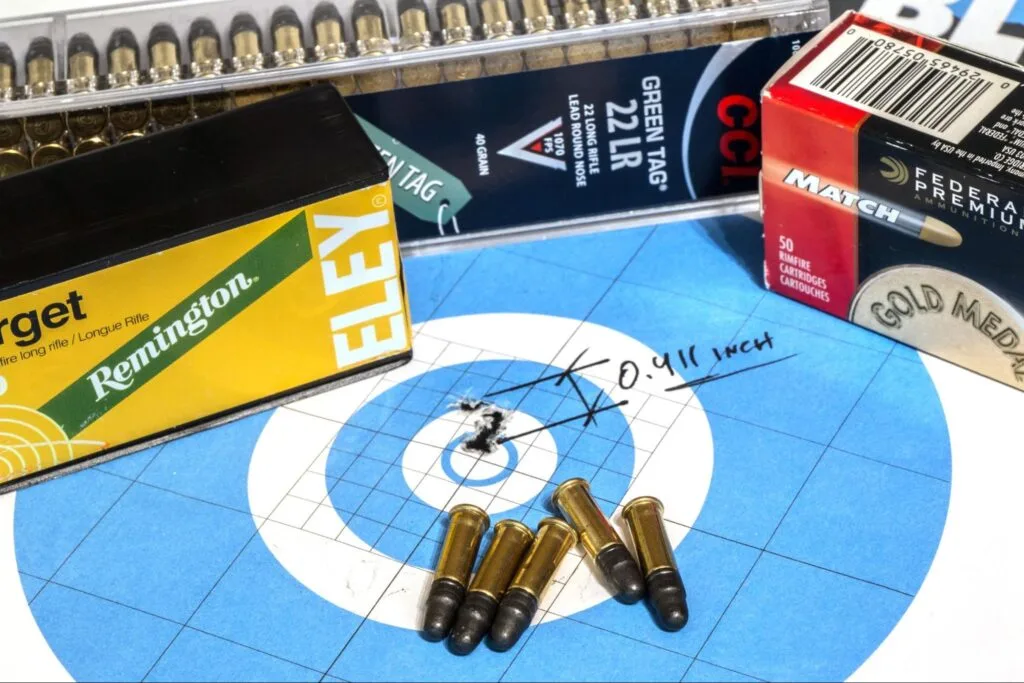
The 22 LR can be exceptionally accurate, especially inside 100 yards. Richard Mann
The primary appeal of rimfire cartridges is affordability and fun. Rimfires are cheaper to shoot than centerfires, and because they’re quieter with minimum recoil, they’re more fun to shoot. Anytime cartridge comparisons are made, fun should be taken into consideration because having fun is at the heart of pulling triggers. For target shooting and plinking, the 22 LR is hard to beat because of its affordability and low report. With the 22 LR, you can blast away 500 rounds for about $50.00. If you shoot 500 rounds of 17 HMR ammo you’re going to have to throw down more than three times that much cash.
Matched with the right 22 LR rifle, the 22 LR can also deliver high levels of precision. With the best 22 LR ammo, you can expect 50-yard groups of a half-inch or less. The 17 HMR however can deliver that same level of precision at 100 yards, often with more affordable rifles. And, if you like plinking or target shooting at extended ranges, it’s much easier to do with the 17 HMR. One reason for this is because 17 HMR bullets remain supersonic out to nearly 250 yards. The fastest shooting 22 LR loads go subsonic at about 100 yards. This transition between supersonic and subsonic flight can negatively impact bullet stability and accuracy.
However, when it comes to plinking, most shooters want to be able to do a lot of it for as little as possible. Let’s say you want to shoot 1000 rounds a year punching paper, busting balloons, and making holes in pop cans. If you do that for 10 years with a 22 LR you’ll spend about $1,000. If you do that with a 17 HMR you’ll spend about $3,800. For that much money, you could shoot almost 40,000 rounds through a 22 LR. Even if you miss the target half the time, that’s a lot of fun on the range for not a lot of money.
Read Next: 6.5 Grendel vs 6.5 Creedmoor
17 HMR vs 22 LR: Hunting
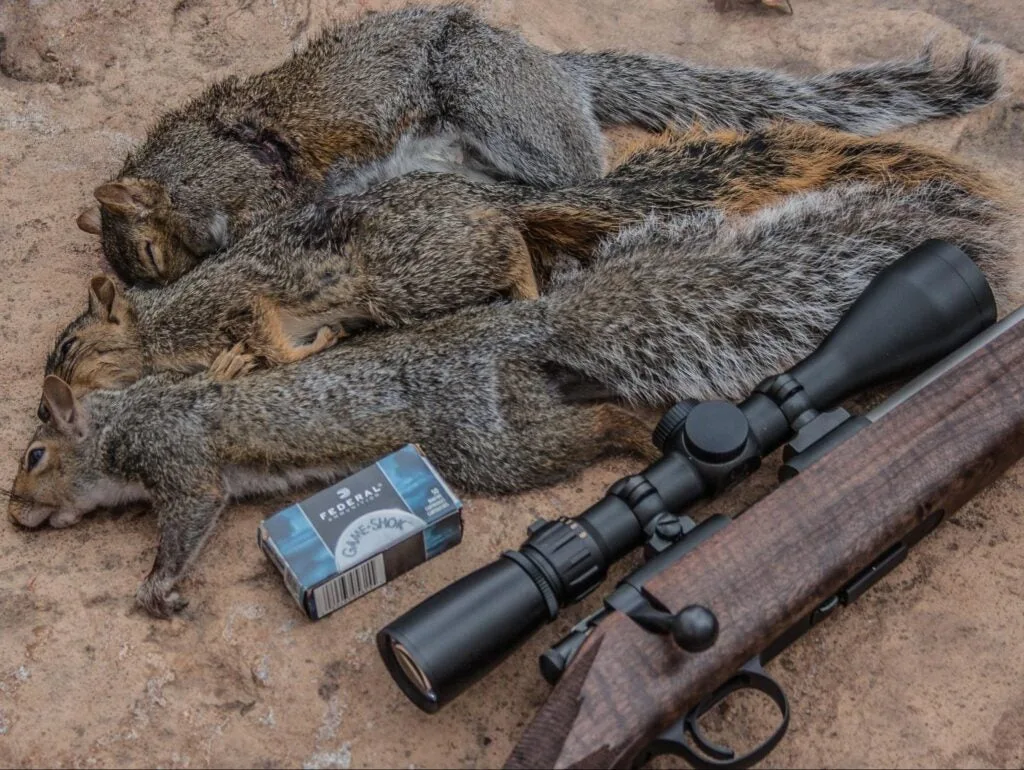
For squirrel hunting, the 22 LR might be the absolute best cartridge. Shots are generally less than 50 yards and the 22 LR will not damage excessive amounts of edible meat. Richard Mann
Downrange precision carries over to hunting; you need to put bullets in the right spot to get your critter. The 17 HMR handily beats the 22 LR when it comes to reach and precision at extended distances. I once killed a prairie dog at 500 yards with a 17 HMR. It did take almost a half-box of ammo to get the first hit, and a couple more shots to get the second hit, but that’s something I could have never done with a 22 LR.
However, when it comes to hunting, it’s not all about long-range precision. For small, edible game like squirrels, you want to get the kill while damaging the least amount of meat possible. Any well-placed 22 LR hollow point bullet will handle any tree squirrel and not destroy excessive amounts of protein. Also, when hunting tree squirrels in the timber, shots typically do not exceed 50 yards. The 17 HMR will give you a lot more reach, but it also delivers a devastating impact. Shoot a common grey squirrel in the shoulder with a 17 HMR and none of that shoulder meat will make it to the plate.
When used inside 50 yards the 22 LR is more than capable of dealing with small game like squirrels, groundhogs, raccoons, and such. It can also be effective on larger game like coyotes. When he was only six years old my son hammered a coyote with his Ruger 10-22, but the range was only about 25 yards, and his rifle was loaded with CCI Stingers. Also, during a prairie dog hunt, I once fired a brick—500 rounds—of 22 LR ammunition in one afternoon. I killed probably 350 prairie dogs and it only cost me about $60.00. Had I been using a 17 HMR I’d have spent about $200.00.
Still, the reach and power of the 17 HMR cannot be overlooked by the hunter. Most loads will carry more than 100 foot-pounds of kinetic energy to 100 yards. The fastest 22 LR loads will be lucky to hit with 80 foot-pounds at that distance. While foot-pounds do not directly correlate with lethality, that energy is used to get the best terminal performance out of the bullets we shoot. Anything you can ethically kill at a certain distance with a 22 LR, you can ethically kill at twice that distance with the 17 HMR.
If high-performance ballistics is all that matters to you, the 17 HMR is the clear choice. When it comes to downrange velocity, energy, trajectory, and accuracy, the 22 LR cannot compare. If on the other hand money matters more to you than the ability to kill a fox at 200 yards, the 22 LR reigns supreme. You might need to get closer to make a lethal shot, but over the course of a lifetime, you’ll save a lot of money and maybe even have more fun.
What Are Some Other Options?
Shortly after the 17 HMR was introduced, some began predicting the end of the 22 Magnum. At that time there were only a handful of loads offered for the 22 Magnum, and most were loaded with a 40-grain hollow point or FMJ bullet. But ammunition manufacturers stepped up and began offering new and better performing 22 Magnum ammunition. Today there are twice as many 22 Mangum loads to choose from as there are 17 HMR loads, and bullet weights range from 25 to 50 grains.
CCI’s 22 Magnum Maxi-Mag ammunition, which is loaded with a 30-grain polymer-tipped bullet, won’t shoot quite as flat but it will hit harder at 100 yards than the 17 HMR. The bullet will also remain supersonic out to about 225 yards. And the cost per round fired is about the same as the 17 HMR. If a lot of plinking is what you want to do, you can also find 22 Magnum ammunition for as little as 28 cents per shot. That’s not as affordable as 22 LR ammo, but it’s 10 cents less per shot than 17 HMR ammo.
Don’t limit yourself to the 17 HMR vs 22 LR question, especially if you’re looking for a rimfire cartridge with general-purpose application. The 22 LR offers the most versatile array of ammunition and is the least expensive to shoot, but for hunting it’s best limited to about 50 yards. The 17 HMR shoots the flattest and is considered the most accurate, but it is expensive and ammunition options are limited. The 22 Magnum on the other hand offers a good balance of everything the 22 LR and the 17 HMR have to offer.
FAQs
Q: What does rimfire mean?
A rimfire cartridge is a self-contained, metallic-cased cartridge that does not have a separate primer. With a rimfire cartridge, the priming compound is in the rim of the cartridge case.
Q: Is the 22 LR lethal?
Lethality, as it relates to ammunition, is a hard word to define. The 22 LR has been used to kill very large animals and even humans. However, for ethical use when hunting, the 22 LR is generally only considered lethal for small game.
Q: Is the 17 HMR good for squirrels?
Squirrels are not hard to kill and the 17 HMR is more than adequate for hunting them, even out to 200 yards. However, if you’re hunting squirrels and want to eat them, the 17 HMR can damage a lot of meat.

